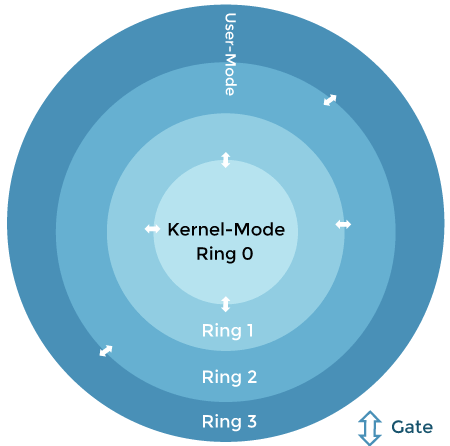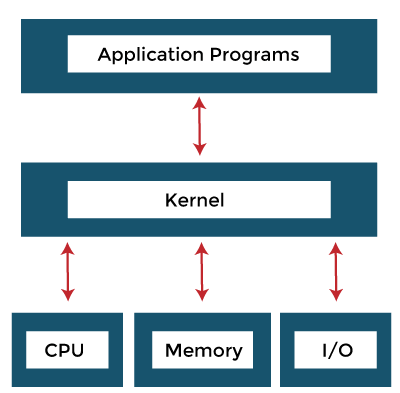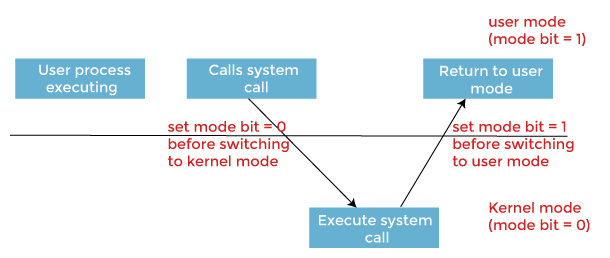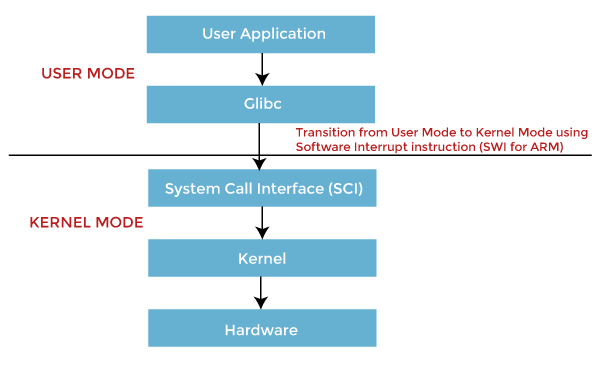Dual Mode Operations in Operating SystemThe dual-mode operations in the operating system protect the operating system from illegal users. We accomplish this defense by designating some of the system instructions as privileged instructions that can cause harm. The hardware only allows for the execution of privileged instructions in kernel mode. An example of a privileged instruction is the command to switch to user mode. Other examples include monitoring of I/O, controlling timers and handling interruptions. To ensure proper operating system execution, we must differentiate between machine code execution and user-defined code. Most computer systems have embraced offering hardware support that helps distinguish between different execution modes. We have two modes of the operating system: user mode and kernel mode. Mode bit is required to identify in which particular mode the current instruction is executing. If the mode bit is 1, it operates user mode, and if the mode bit is 0, it operates in kernel mode. NOTE: At the booting time of the system, it always starts with the kernel mode.Types of Dual Mode in Operating SystemThe operating system has two modes of operation to ensure it works correctly: user mode and kernel mode. 1. User Mode When the computer system runs user applications like file creation or any other application program in the User Mode, this mode does not have direct access to the computer's hardware. For performing hardware related tasks, like when the user application requests for a service from the operating system or some interrupt occurs, in these cases, the system must switch to the Kernel Mode. The mode bit of the user mode is 1. This means that if the mode bit of the system's processor is 1, then the system will be in the User Mode. 
2. Kernel Mode All the bottom level tasks of the Operating system are performed in the Kernel Mode. As the Kernel space has direct access to the hardware of the system, so the kernel-mode handles all the processes which require hardware support. Apart from this, the main functionality of the Kernel Mode is to execute privileged instructions. 
These privileged instructions are not provided with user access, and that's why these instructions cannot be processed in the User mode. So, all the processes and instructions that the user is restricted to interfere with are executed in the Kernel Mode of the Operating System. The mode bit for the Kernel Mode is 0. So, for the system to function in the Kernel Mode, the Mode bit of the processor must be equal to 0. ExampleWith the mode bit, we can distinguish between a task executed on behalf of the operating system and one executed on behalf of the user. 
Need for Dual-Mode OperationsCertain types of processes are to be made hidden from the user, and certain tasks that do not require any type of hardware support. Using the dual mode of the OS, these tasks can be deal with separately. Also, the Operating System needs to function in the dual mode because the Kernel Level programs perform all the bottom level functions of the OS like process management, Memory management, etc. If the user alters these, then this can cause an entire system failure. So, for specifying the access to the users only to the tasks of their use, Dual Mode is necessary for an Operating system. So, whenever the system works on the user applications, it is in the User mode. Whenever the user requests some hardware services, a transition from User mode to Kernel mode occurs, and this is done by changing the mode bit from 1 to 0. And for returning back into the User mode, the mode bit is again changed to 1. User Mode and Kernel Mode SwitchingIn its life span, a process executes in user mode and kernel mode. The user mode is a normal mode where the process has limited access. However, the kernel-mode is the privileged mode where the process has unrestricted access to system resources like hardware, memory, etc. A process can access services like hardware I/O by executing accessing kernel data in kernel mode. Anything related to process management, I/O hardware management, and memory management requires a process to execute in Kernel mode. This is important to know that a process in Kernel mode get power to access any device and memory, and same time any crash in kernel mode brings down the whole system. But any crash in user mode brings down the faulty process only. The kernel provides System Call Interface (SCI), which are entry points for user processes to enter kernel mode. System calls are the only way through which a process can go into kernel mode from user mode. The below diagram explains user mode to kernel mode switching in detail. 
Why do we need Switching?There are two main reasons behind the switching between User mode and kernel mode, such as:
So, the overhead of switching is acceptable to ensure a more stable, secure system. Difference between User Mode and Kernel ModeA computer operates either in user mode or kernel mode. The difference between User Mode and Kernel Mode is that user mode is the restricted mode in which the applications are running, and kernel-mode is the privileged mode the computer enters when accessing hardware resources. The computer is switching between these two modes. Frequent context switching can slow down the speed, but it is impossible to execute all processes in the kernel mode. That is because; if one process fails, the whole operating system might fail. Below are some more differences between User mode and kernel mode, such as:
Next TopicWhat is Access Token in Operating System
|
 For Videos Join Our Youtube Channel: Join Now
For Videos Join Our Youtube Channel: Join Now
Feedback
- Send your Feedback to [email protected]
Help Others, Please Share










